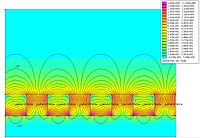
Photo from wikipedia
ABSTRACT Extensive laboratory and commercial test works have been carried out on wet belt high gradient permanent magnetic separation (WBHGMS) and these works demonstrated that it is effective in purification… Click to show full abstract
ABSTRACT Extensive laboratory and commercial test works have been carried out on wet belt high gradient permanent magnetic separation (WBHGMS) and these works demonstrated that it is effective in purification of non-metallic ores such as quartz and feldspar. The WBHGMS process is achieved with a thin plate-type magnet and its length produces a decisive role in the separation performance. In this investigation, the separation dynamics of particles in the inclined slurry in a high gradient magnetic field and the relationship between magnet length and separation performance were analyzed, and a pilot-scale WBHGMS separator was used to purify a quartz ore to confirm the analysis. The separation results indicate that the magnet length has definitely a dominant control on the separation performance of the separator and its performance is connected with the variables such as magnet inclination angle, belt rotation speed and feed particle size. The iron removal rate was increased with decrease in the Fe2O3 grade of non-magnetic product, as the magnet length is increased. Under the optimized operating conditions, the pilot-scale separator produced a non-magnetic product assaying 0.065% Fe2O3 at a mass weight of non-magnetic product of 75.51% and an iron removal rate of 75.46% from the quartz ore assaying 0.20% Fe2O3. This investigation has provided a detailed description on the optimum design for magnet length in a given WBHGMS separator and it is favorable for the performance improvement of the separator.
Journal Title: Separation Science and Technology
Year Published: 2018
Link to full text (if available)
Share on Social Media: Sign Up to like & get
recommendations!